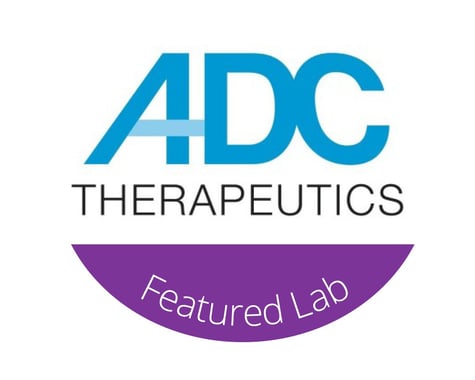
“The number of samples that can be analyzed has vastly increased, as the lab team can write the experiments and results in less than one hour. I estimate that we can save a day per week by using the ELN rather than having to search, scan, print and compile everything together in a printed lab notebook.”

Charlie Britten, ADC Therapeutics
We interviewed Charlie Britten, scientist at ADC Therapeutics, and asked him about his group’s experience of using Labguru’s cloud-based lab management systems.
Tell us about ADC Therapeutics
ADC Therapeutics is a clinical-stage oncology drug discovery and development company focused on advancing our proprietary antibody-drug conjugates (ADCs) for the treatment of hematological cancers and solid tumors.
Our ADCs are highly targeted biopharmaceutical drugs that combine monoclonal antibodies specific to surface antigens present on particular tumor cells with a novel class of highly potent pyrrolobenzodiazepine (PBD)-based warheads via a chemical linker to selectively kill cancer cells. The selective targeting and unique mechanism of action enables the potential for our therapies to have enhanced efficacy.
ADC Therapeutics was founded in 2012, and we have raised $455 million since that time to advance our pipeline of programs. We are based in Lausanne, Switzerland and have operations in London (R&D), New Jersey (Clinical) and San Francisco (CMC).
The team at ADCT has a deep understanding of ADCs and the oncology treatment landscape. We are dedicated to efficiently progressing our potential best-in-class PBD-armed ADCs to address significant unmet medical needs and improve outcomes for people with cancer.
What is your role in ADC Therapeutics lab?
I look after method development work at ADC Therapeutics for internal and outsourced assays for R&D and regulatory compliant work.
What were the key challenges your lab was facing?
When we started the lab in 2012, we were using paper lab notebooks. We quickly found that based on the sheer amount of data we were producing, it was not feasible to continue using the print notebooks.
We work closely with colleagues located in various locations around the world as well as visiting different sites ourselves, it was a challenge for us to be able to view all our data from wherever we are working in one place and collaborate easily.
Why did you choose Labguru?
We needed to find an Electronic Lab Notebook solution. We looked at several options but for most of them, there were severe limitations. They were either locally hosted, or the timescale to set them up was too long, or they had limited functionality. Labguru was the only solution which gave us both the flexibility and control to meet our need.
Critically, Labguru also provided a cloud-based laboratory data management system to serve different people working in different locations. This was an essential selling point for us as we wanted to be able to view the lab work from different locations. The data in Labguru is very structured and ordered to enable a better overview. We also liked the fact that we can create a PDF report of an experiment or method and send it immediately to a colleague who does not have Labguru.
Reagents and other consumables are also managed in Labguru but the main application is the electronic lab notebook (ELN).
What was your overall Goal when you started using Labguru?
We wanted to increase efficiency, productivity, and collaboration by migrating from a paper workflow to an electronic lab notebook.
What Labguru features do you like most and find critical for your work?
A key utility for us is the integrated and linked information in Labguru. In Labguru you can link anything together and integrate all information and assets in one system. One team member can order reagents and link them into experiments, recipes, and protocols. This would be very difficult to achieve in a locally loaded system as these types of systems are made up of separate parts – one for managing stocks, one for recording data and all of these different parts working independently of each other. With Labguru you can see where an entity, for example, an antibody, was used across a list of experiments. This makes it easier to find data, troubleshoot issues and establish the suitability of entities for different experimental tasks. The ease and speed with which we can find information is really a key feature for us.
How do you deal with raw research data?
At ADCT we perform several lab techniques which generate a lot of data files such as flow cytometry, and in this context, our team needs to be able to retain and integrate the raw data in the documented experiment. It was a serious pain point when trying to do work in flow cytometry with paper-based lab notebooks. The bottleneck with printed lab notebooks was that you can’t print 200 or 300 pages of the raw data that you need to output from this type of work. With an ELN, you can flow this raw data directly alongside the experimental summary and the graphs visualizing the results. We also need the raw data to be easily accessible, in the right context, to anyone across the lab, so that conclusions that can be independently checked and verified. We need this because we need to do random checks on the data. This is all easily done in Labguru.
Can you describe the ROI you see from Labguru?
After a few months of using Labguru, we estimated that we gained one day a week per analyst of lab time from reduced time spent writing up experiments in paper notebooks. After using Labguru for around four years I would say this still hold true, and in some cases may even be a little more. A large amount of the time saving comes from attaching data via a drag and drop and not having to scan, print and compile everything together in a paper lab notebook. We have tablets for recording information in the lab which means information can be added in real‑time meaning not only a time saving but also a reduced chance of error.
There is also a strategic advantage from the operational increase in productivity: When you get a higher throughput of sample analysis and completed experiments, the team can make decisions faster, meet milestones to help move more quickly towards our scientific and commercial goals.
To schedule a demo and learn more about how to improve your labs’ efficiency – Contact Us
Read More Blog Posts:



